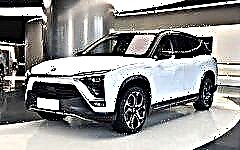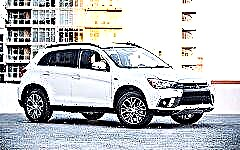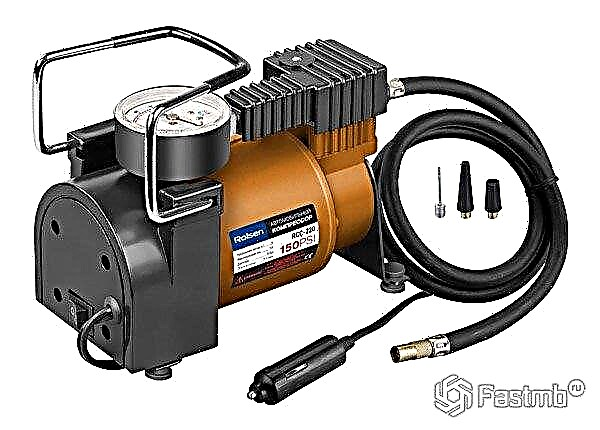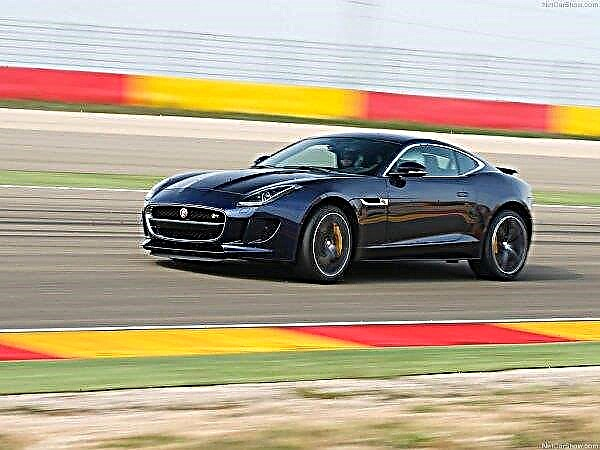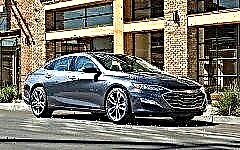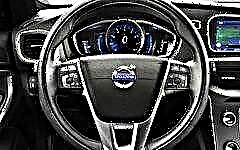

The content of the article:
- What is an electric amplifier
- Mechanism device
- Scheme
- Principle of operation
- Pros and cons
- Major malfunctions
- Repair and parts price
Electric power steering of the car (electric power steering) - designed to minimize the driver's efforts when turning the steering wheel. Thereby increasing comfort and safety. The main plus is the complete absence of hydraulic elements and mechanisms in the system, which also increases the safety of the car. Thanks to the electronics that power the amplifier, engineers were able to implement many additional functions that cannot be installed on a hydraulic amplifier.
What is electric power steering

The electric booster is a high-tech unit that eliminates hydraulics and operates entirely on the basis of electronics. If we compare hydraulics and electronics, then the latter is rapidly gaining popularity, both among drivers and manufacturers. The main plus is the cost of production, which is an order of magnitude less than the hydraulic one, moreover, it practically does not require attention.
Most of the control falls on sensors and electronics, which monitor the driver's actions, analyze the received data and transmit signals to the actuators to turn the wheels. Among the frequent breakdowns, they are more likely to be of the nature of a defect, flaws in management, wear of parts, and so on. Meanwhile, the manufacturer takes into account all kinds of shortcomings and, as far as possible, eliminates them. Generally speaking, about quality and comfort, the main advantage is the absence of vibration and shock transmission to the steering wheel.
How does the electric power steering of a car work?

If the main purpose of the electric power steering is clear, then the principle of the structure is completely different from the classic power steering. Today, the EUR device (electric booster) largely depends on the car manufacturer, but experts identify the classic version, the device of which does not change. The standard set includes an electric motor on the steering column, a mechanical transmission (gear), as well as a control system based on an electronic unit. Each of the listed details has an important role to play.
For example, electric motor (electric motor), as a rule, it is an asynchronous motor that drives the power steering. Although here, there are several schemes and principles for installing such an electric motor. The first option is when the electric motor transmits the force directly to the steering shaft. The mechanism is installed on the steering column by means of a mechanical transmission (gears or worm gear), the force is transmitted from the engine to the steering wheel. As practice shows, this version of the electric amplifier device outlasts its own and is less in demand.

The second installation option, when the electric motor transmits the force to the steering rack itself. We can say this is a more practical version of the electric booster device and more popular (common) among modern cars. There are two main subspecies, when the power transmission is carried out through two gears or by means of a parallel drive. With a parallel drive, the power of the electric motor is transmitted directly to the steering rack of the entire mechanism, by means of a belt or a ball screw. If the EUR is based on two gears, then the force is transmitted to the steering rack from the steering wheel due to one gear. As for the second gear, the force is transmitted to it using an electric motor.
An equally important element of an electric amplifier is considered reducer... It looks like a mechanical transmission, consisting of a gear and a worm element. Depending on the device of the electric booster and the car model itself, this connection can change shape, as well as the device itself. The main task is considered to be the conversion of the steering effort to the steering rack or from the steering wheel to the electric motor. The parts are connected to each other, as a rule, at an angle of 90 degrees.

The last and most irreplaceable part of the electric power steering is electronic control unit... We can say that this is the heart of the entire mechanism, since it is he who receives signals, processes them and further actions of other mechanisms of the system are decided. By the structure of the structure - a set of microcircuits, a logic block, fuses and other elements responsible for the operation of the electronic board.
In addition to the listed main mechanisms, steering wheel turn sensors (left and right), torque sensors (reactive force) are also distinguished. There are also defense mechanisms that are responsible for controlling and minimizing certain values. For example, steering angle - driving style recognition, sporty or smooth urban. Wheel turning speed - depending on the wishes of the driver or the selected suspension mode. Such elements are responsible not only for the electric power steering, but also for the control of other parts of the car (suspension, engine and transmission). Thanks to the use of electronics in the power steering, engineers managed to combine previously separate mechanisms into one whole, and through electronic control units - to teach them to interact with each other.
Electric power steering diagram of a car

The photo shows a diagram of the electric power steering of a car
- steering wheel;
- steering column;
- propeller shaft for steering force transmission;
- amplifier electric motor (electric motor);
- sensor for determining the torque;
- steering gear;
- amplifier electronic control unit.
Depending on the make and model of the vehicle, the laugh of the electric power steering device may differ. In addition, additional sensors can be installed, as well as communication with other security and comfort systems.
How does electric power steering work

The principle of operation of the electric power steering of a car is somewhat reminiscent of the classic version of the power steering, but with refinement in the direction of electronics. The whole beginning starts from the moment the steering wheel is turned to the left or to the right. At this moment, the torsion bar (torsion shaft) is twisted and movement occurs on its reverse side. In turn, the steering angle sensors and the torque sensor read the information and transmit it to the electronic control unit. The ECU calculates the information received, compares the data with other sensors and systems and, as a result, calculates the force for the electric motor, which must be applied to make it easier for the driver to turn the steering wheel.

The amplifier motor does not stand aside. Having received a command from the control unit, it begins to act on the steering shaft or steering rack (depending on the type of electric booster). The speed of the amplifier's electric motor is directly proportional to the current strength. The more current is supplied to the electric motor, the faster it rotates the mechanism, respectively, the lower the current, the slower the motor will rotate. In addition to the basic principle of operation of the electric power steering mechanisms, situations are also distinguished in which the mechanism will work out different modes (certain details change the settings). There are 5 main situations:
- the system supports the wheels in the middle, basic position;
- the car turns at low speed;
- the mechanism returns the wheels to the middle position from the extreme;
- the car is turning at high speed;
- other options for turning the car at the normal permissible speed.
It is for these modes that conclusions can be drawn about the quality of the electric amplifier, as well as its capabilities, comfort and safety. Having worked out the whole chain, finally the steering force is transferred to the steering rack, steering rods and to the drive wheels to change the trajectory of the car.
Positive and negative points of the electric power steering

Like any mechanism, the electric power steering has positive and negative points, both in terms of comfort and the structure of the mechanism. To begin with, consider the disadvantages of the mechanism:
- the electric booster mechanism is mostly used on passenger cars, since the power is not enough for trucks (last year Volvo has been working on an electric booster for trucks);
- high cost in comparison with hydraulics;
- low moisture protection.
On the positive side of the electric booster, it can be noted:
- significant fuel savings, since there is no load on the engine;
- reliability (no hydraulic system and no fluid leakage option);
- better interaction between the driver and the mechanism;
- lack of vibration transmission from the wheels to the steering wheel;
- ease of maintenance and compactness of mechanisms;
- a wide range of options for adjusting characteristics;
- the possibility of implementing other auxiliary systems for the driver.
This is a minimal list of what can be positive and negative about electric power steering. The main and biggest plus of the differences from hydraulics is the possibility of implementing additional safety systems, for example, an autopilot, an automatic parking system, a steering mechanism and keeping the car on the lane, as well as dozens of other possibilities.
Frequent malfunctions of the electric booster

No matter how ideal the electric booster mechanism is, sooner or later it will need repair or replacement of individual parts. To understand how such a mechanism can upset the driver, we will consider the most basic and frequent malfunctions of the mechanism. The first and main symptom of a malfunction of the electric booster is the appearance of a corresponding indicator, in the form of a steering wheel with an exclamation mark on the instrument panel. It is not excluded the option when instead of the image of the steering wheel, the manufacturer uses the abbreviated inscription "EPS". This is essentially the same thing, only the difference in standardization and the period of production of the car.
As practice and statistics show, sensors most often come from technical parts, in particular a steering angle sensor and a torque sensor. The electric motor can also fail, because the main control and constant movement is carried out at its expense. In conclusion, the electronic disk in modern cars is also referred to malfunctions, due to which the steering angle is read, as well as sharpness and effort.
Least of all, the electronic control unit fails, since parallel control is arranged in it. In other words, in most ECUs, another backup unit is arranged, in case the first fails. In addition, such a device allows you to evenly distribute the load in processing the information received. We can say that most often movable mechanisms fail, although manufacturers take into account all these shortcomings and modify them in order to improve safety and comfort. Modern cars in their set include not only the classic set of electric booster, but also parasitizes on other security systems, using their sensors and processed information from control units.
The cost of parts and repair of an electric booster

As already mentioned, the electric amplifier is not whimsical, but still what can be expected when this or that part of the mechanism comes out, how much will such a repair cost and how much approximately the parts will be pulled out of the pocket. To begin with, consider the cost of parts for an electric amplifier, since most of the repairs can be done independently.
| The cost of parts for an electric power steering of a car | |||
| Name | Car brand, model | Price from, rub. | Price from, UAH |
| Steering rack | Lexus CT200H, GS300 | 24100 | 9512 |
| Electric motor | VAZ Kalina | 7500 | 3000 |
| Control block | Nissan X-Trail T31 | 3450 | 1359 |
| Steering rack | Toyota RAV-4 2006-2012 | 16950 | 6761 |
| Control block | Chevrolet Captiva C140 | 1350 | 541 |
| Cable harness | VAZ 1118 | 1875 | 750 |
It would seem that the control unit should be the most expensive, but as practice shows, only 1% of 100% of breakdowns are caused by the ECU, while the rest of the problems happen with the steering rack, electric motor or other trifles. Considering the state of the road and unpredictable situations, the main shocks and vibrations occur on the electric motor, and the very design of this element is not simple.

Accordingly, hence such a high cost, the more expensive and higher in the class a car, the more expensive the electric booster parts are. If, for some reason, it is not possible to repair it yourself at home, consider how much such a repair will cost at a service station.
| Repair and maintenance cost | ||
| Name | Price from, rub. | Price from, UAH |
| Removal and installation of the steering rack | 1250-3750 | 500-1500 |
| Steering rack repair | 3750-7500 | 1500-3000 |
| Rack adjustment (without lowering the subframe) | 250-500 | 100-200 |
| Rack adjustment (with lowering of the stretcher) | 500-1250 | 200-500 |
| Diagnostics of EGU elements (engine, sensors, gears) at the stand | 500 | 200 |
The cost of repairs is not the cheapest, but also not as high as for a hydraulic booster. The most difficult thing will be with an electric motor, since the device is accurate and requires practice to repair such elements. As for the electric booster as a whole, the system not only improved the comfort for the driver and the safety of the car in general, but also allowed the installation of many additional auxiliary systems. In addition, there is an unlimited flight of fantasies for the implementation of new systems, which in the future can completely replace the driver or significantly facilitate control.

